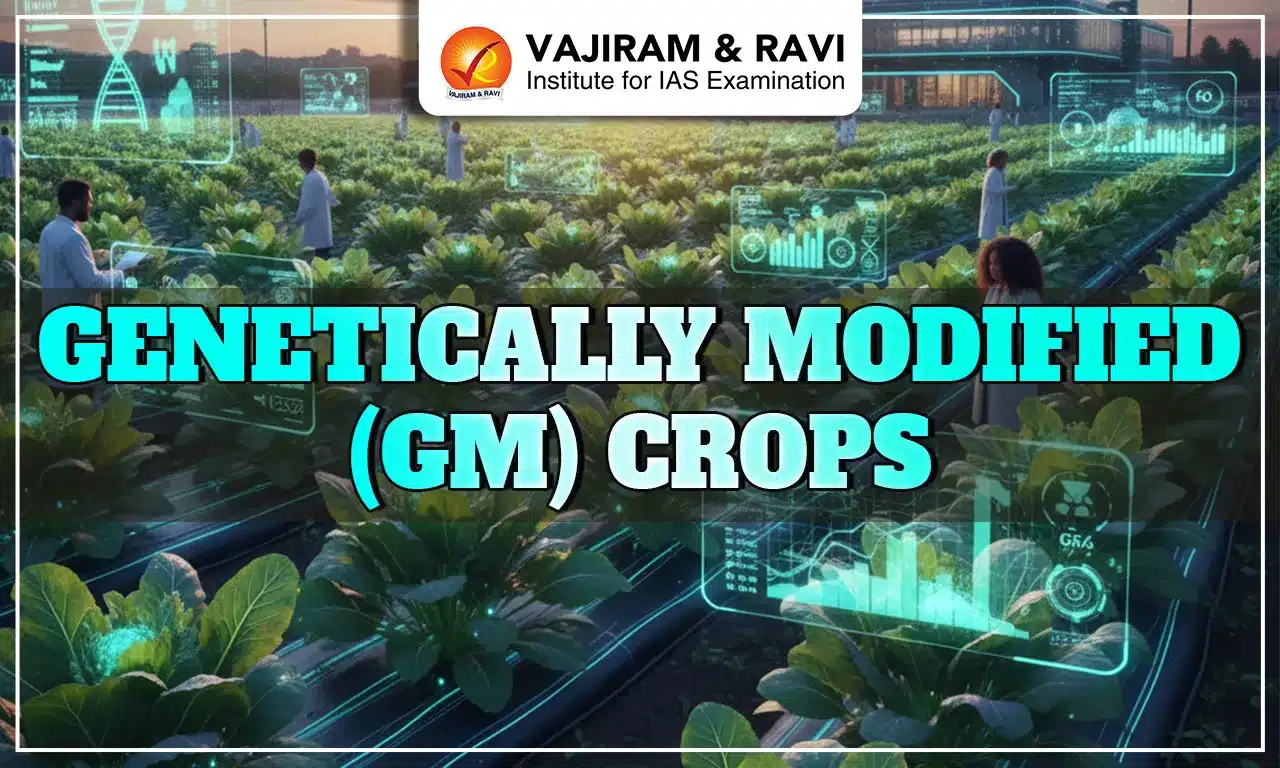Genetic modification (GM) is a technology that involves inserting DNA into a host organism's genome. Plant genetic modification entails inserting a specific stretch of DNA into the plant's genome to confer new or different characteristics such as making it resistant to a specific disease. The most widely grown GM crops worldwide are cotton, soybeans, maize, and canola with herbicide tolerance and insect resistance.
USA, Brazil, Argentina, India, and Canada are the five top GM-growing countries, together accounting for approximately 90% of area of the GM cultivation.
GM Crops and their Development
GM crops were first introduced in the USA in 1994 called Flavr Savr tomato, with the objective to slow its ripening process, delaying softening and rotting. Before this, genetic modification was already in use to produce insulin, vaccines, and other drugs on a large scale.
- Objectives of the GM crops:
- Reducing dependence on pesticides/herbicides as the toxins produced by the GM crops (such as Bt-toxins) are used to kill the pests
- Providing resistance to certain plant viruses
- Providing tolerance of herbicides used to control weeds
- Reducing the need to till the soil to control weeds
- Bt genes:
- Bacillus thuringiensis (Bt) is a bacterium that produces two important proteins - cytolytic (Cyt) and crystal (Cry) toxins, which are toxic to a specific group of insects such as beetles, caterpillars, flies, mosquitoes, etc.
- The genes expressing these toxins are engineered into plant crops so that they too have the ability to produce them. For example: Bt Cotton.
Methods of producing GM Crops
To genetically modify a crop, a gene of interest (Cry or Cyt genes, or any other gene for a specific trait) is incorporated into the DNA of a plant. It involves mainly two approaches - Recombinant DNA technology using Agrobacterium tumefaciens-mediated gene transfer and the Direct approach.

- Direct approach: In the direct approach the gene of interest is cloned into a plant DNA vector and then transferred into the plant using the gene gun method, electroporation method, microinjection, etc.
- In the gene gun (particle bombardment) method, tiny particles of gold or tungsten are coated with the DNA (gene) solution and introduced into the plant using the gene gun or particle gun.
- A.tumefaciens mediated gene transfer: A.tumefaciens is a soil bacterium and is called nature’s own genetic engineer. It causes crown gall disease in many plants by transferring tumour-causing DNA into the plant’s genome by using a tumour-inducing plasmid (Ti-plasmid).
- This Ti plasmid can be utilised to make recombinant DNA, after removing the gene that causes gall disease.
The recombinant T-DNA is then transferred to the plant using A.tumefaciens.

Advantages of Genetically Modified Crops
GM Crops have several advantages which include:
- Better than conventional breeding: Genetic Modification is one of the best methods to develop pest-resistant crops such as Bt crops.
- It is faster to introduce the required traits than by the conventional breeding process.
- It enables genetic modification in such a way that may not have been possible through conventional breeding methods, such as the introduction of a gene from different organisms.
- Pest resistance: The Bt genes are toxic to many pests, thus eliminating the need for externally applied chemicals.
- This reduces the need for environmentally damaging pesticides.
- This increases yield, saves farmers’ money and reduces environmental pollution.
- Virus resistance: Virus-resistant traits can be introduced into vulnerable plants that lack natural resistance.
- This increases the productivity of crops.
- Drought-resistant plants: Plants can be modified to express tolerance to drought hence, it reduces the use of groundwater.
- Herbicide tolerance: GM crops are engineered to be resistant to specific herbicides that can be used to control weeds.
- It reduces soil erosion because the weed removal process such as ploughing and tilling is not required for these crops.
- This also reduces soil, water and air pollution.
- Sustainable agricultural practice: Genetically modified crops enable farmers to use more sustainable agricultural practices, such as no-till farming, which keeps the carbon within the soil rather than in the atmosphere.
- Enhanced nutritional value: Food crops can be modified genetically to increase their nutritional value.
- This can be beneficial to health, and increase food security around the world.
Disadvantages of Genetically Modified Crops
The unknown consequences of GM crops that can lead to the horizontal gene transfer of pesticide, herbicide, or antibiotic resistance thereby affecting the metabolism and response to the external environmental stimulus of the hosts are some of the concerns of this technology.
- Impact on Health: Horizontal gene transfer of pesticide, herbicide, or antibiotic resistance to other organisms would put not only humans at risk but also cause ecological imbalances by causing the spread of disease among both plants as well as in animals.
- Impact of herbicide-tolerant crops: Herbicide overuse in fields may allow weeds to develop resistance to them.
- For example: Glyphosate has been used as a herbicide in the United States since 1974, and its widespread usage has resulted in glyphosate-resistant weeds.
- Impact of pest resistance:Pests may acquire resistance to pest-resistant traits such as Bt toxins produced by the Genetically Modified crop, which can overcome the efficacy of these crops.
- Impact on genetic diversity in crop varieties: Concerns have been raised about the possibility of GM crops reducing the genetic diversity of neighbouring crops, close relatives, and weeds.
- Herbicide-resistant weeds: Weeds may also cross-breed with herbicide-tolerant crops, resulting in herbicide-tolerant weeds, which is more worrisome.
- Effect on honeybees and other pollinators:There is a worldwide growing concern that Genetically Modified crops may endanger the honeybee population and other pollinators.
Applications of GM Crops
Following are some of the applications of GM technology in plants that are being used today.
- Biofortification: Biofortification is the process of enhancing micronutrient content.
- Genetic modification has proved to be the best method for biofortification.
- Example: β-carotene-enriched ‘Golden Rice’ was the first application of GM biofortification in 2000.
- It can also prevent many diseases such as cancer, diabetes and cardiovascular diseases.
- Edible Vaccines: Edible vaccines can be produced from GM plants.
- They offer many benefits than the traditional ones due to lower manufacturing costs and much fewer side effects.
- Biofuels: Fourth-generation biofuels, which is biofuel obtained from genetically modified (GM) algae and cyanobacteria, have gained considerable attention.
- Phytoremediation: Genetic modification can be utilised to clean up soil and water pollutants by expressing the particular genes that express enzymes dealing with these pollutants.
India and GM Crops
There is an array of GM crops, brinjal, tomato, maize, and chickpea which are in various stages of trials in India. India is one of the leading producers of Genetically Modified crops in the world.
Regulatory Framework
Stringent laws are in place to address threats to animal health, human safety, and biodiversity in general during the development, cultivation, and transboundary movement of GM crops.
- Statutory bodies on GM crop regulation:
- Recombinant DNA Advisory Committee (RDAC): It monitors the development of biotechnology at national and international levels.
- Review Committee on Genetic Manipulation (RCGM): It reviews ongoing projects involving high-risk and controlled field experiments.
- It also approves the applications for generating research information on GM plants.
- Genetic Engineering Appraisal Committee (GEAC): It is responsible for the overall evaluation of proposals related to the release of GM organisms as well as products into the environment. It works under the Ministry of Environment.
- GEAC Safety Assessment tests: Molecular characterisation, food safety studies, and Environmental safety studies including field trials, impact on soil, pollen flow studies, etc.
- State Biotechnology Coordination Committee (SBCC): It reviews safety measures in various institutions handling GM organisms and acts as the state-level nodal agency in this regard.

Status of GM Crops in India
- Bt-Cotton: In 2002, India commercialised Bt Cotton, which resulted in a significant improvement in cotton production, export, and the textile industry.
- It is the only approved GM crop for commercial cultivation in 2002.
- It was created to combat the widespread infestation of bollworms.
- Bt-Brinjal: The fruit and borer-resistant Bt-brinjal was approved for commercial cultivation by GEAC in 2009, but it was put on a 10-year moratorium due to public outrage and recommendations from brinjal-growing states.
- GEAC has approved field trials of new varieties of indigenously developed Bt-brinjal in eight states from 2020 to 2023.
- GM Mustard: Commercial cultivation of high-yielding GM mustard in India has not begun yet.
Last updated on January, 2026
→ Check out the latest UPSC Syllabus 2026 here.
→ Join Vajiram & Ravi’s Interview Guidance Programme for expert help to crack your final UPSC stage.
→ UPSC Mains Result 2025 is now out.
→ UPSC Notification 2026 Postponed for CSE & IFS which was scheduled to be released on 14 January 2026.
→ UPSC Calendar 2026 has been released.
→ UPSC Prelims 2026 will be conducted on 24th May, 2026 & UPSC Mains 2026 will be conducted on 21st August 2026.
→ The UPSC Selection Process is of 3 stages-Prelims, Mains and Interview.
→ Prepare effectively with Vajiram & Ravi’s UPSC Prelims Test Series 2026 featuring full-length mock tests, detailed solutions, and performance analysis.
→ Enroll in Vajiram & Ravi’s UPSC Mains Test Series 2026 for structured answer writing practice, expert evaluation, and exam-oriented feedback.
→ Join Vajiram & Ravi’s Best UPSC Mentorship Program for personalized guidance, strategy planning, and one-to-one support from experienced mentors.
→ UPSC Result 2024 is released with latest UPSC Marksheet 2024. Check Now!
→ UPSC Toppers List 2024 is released now. Shakti Dubey is UPSC AIR 1 2024 Topper.
→ Also check Best UPSC Coaching in India

















